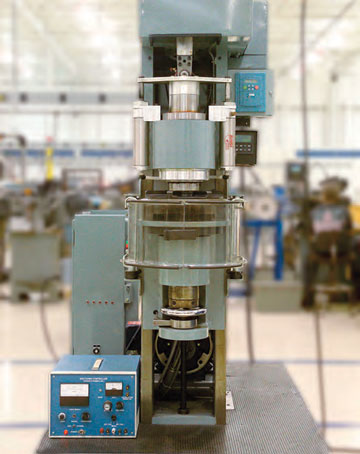Wave Spring Work Height and Compression
What Happens if I Compress My Wave Spring Below Work Height?
 Understanding how and when a wave spring can fail is important for achieving optimal performance in your application.
Understanding how and when a wave spring can fail is important for achieving optimal performance in your application.
One common reason a wave spring could fail is because of overstressing, otherwise known as over-compression of the spring.
How Do You Overstress a Wave Spring?
Compressing a wave spring below the design work height may overstress a wave spring.
Take the following scenario, for example:
You order a standard Crest-to-Crest spring, C100-H7, which has a free height of 1.00" and carries a 25 lb load at a working height of 0.541". The spring had the dimensions you were looking for, but you needed a higher load than it was designed for.
To achieve a higher load, the wave spring must be compressed beyond the designated work height.
So what happens?
So you decide to compress the wave spring below its working height, and the next thing you know, the spring has plastically deformed and your application failed.
This is where our engineering team can come into play. Our team of engineers can help you determine the feasibility of compressing the spring to a lower work height to potentially achieve a higher load on a standard part.
Why Did My Spring Fail When I Compressed It Below the Specified Work Height?
If you compress your spring past the designed work height, you risk having the compressive stresses exceed the tensile strength. When this occurs, the spring could yield or take a set.
If a wave spring takes a set, it will not spring back to its original free height, resulting in a reduction of load at the same work height.
How Can I Avoid Overstressing My Spring?
To avoid overstressing your spring, compression to the specified work height is recommended. The designed work height for all of our standard parts was selected based on the optimal height to use the spring without any deformation.
What if I have to compress my spring below work height?
If you come across application constraints and cannot comply with the designated work heights, you have the following three options:
1. Performance Testing

Compressing a wave spring beyond the work height may very well work in your application. It depends on a variety of factors, including the actual design and cycle life required of the wave spring. We offer free samples for all of our standard parts so you can test the performance in your application.
Important note: Compressing beyond work height may reduce cycle life due to higher stresses, accelerating fatigue. If cycle life is critical in your application, cycle testing in your application is recommended.
To see if your standard wave spring can function at a height other than the designated work height, you may use the Spring Design Calculator to quickly determine the spring operating stresses.
Our engineers can also review the operating stresses for you.
In cases where the stresses are too high and compressing below work height is not feasible, our team can step in and tailor a custom spring that best meets your requirements.
Key Takeaways
- You can ensure optimal wave spring and application performance by compressing your spring to the listed work height.
- Compressing below work height may result in the wave spring taking a set, resulting in load loss.
- If you’re concerned about the load or compressing the spring to solid, ask a China Wave Spring expert today.
- Request Free Samples to ensure performance in your application.

-WaveSpring-01.png)

Connect With Us